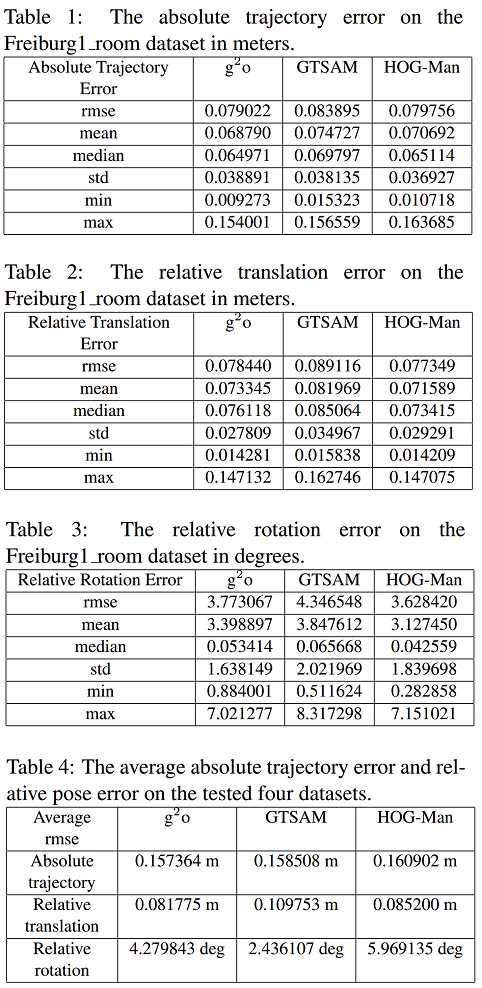标签:
摘自 Comparison of Optimization Techniques for 3D Graph-based SLAM Doaa M. A.-Latif et al. (2013) Ain Shams University PDF
This paper presents a comparison of the recent methods for graph optimization in terms of translation, rotation, and trajectory errors on a standard RGBD datasets of indoor environments. In our study we have compared the performance of 3 different global optimizers:
1. General (Hyper) Graph Optimization
Known also as g2o [1]. It is a C++ framework for performing the optimization of nonlinear least squares problems that can be embedded as a graph or in an hyper-graph.
2. Georgia Tech Smoothing and Mapping
Known also as GTSAM [2]. It is a C++ library based on factor graphs. A factor graph consists of factors connected to variables. The factors represent probabilistic information on the unknown random variables in the estimation problem.
3. Hierarchical Optimization on Manifolds
Known also as HOG-Man [3] it applies Gauss Newton with sparse Cholesky factorization that considers a manifold representation of the state space to better deal with the camera rotations.
Experiments:
All the tests were performed using an Intel Corei7-3610QM CPU @ 2.30GHz × 8 running a 32bit Linux 3.2.0. We used four of the CVPR group [4] datasets in our tests: Freiburg2_xyz which contains data for debugging translations where the Kinect was moved along the principal axes in all directions, Freiburg2_desk which captures the details of a typical office scene with two desks, a computer monitor, keyboard, phone, chairs, etc. with the Kinect moving around two tables so that the loop is closed, Freiburg1_room which has been recorded through a whole office environment and is well suited for evaluating how well a SLAM system can cope with loop-closures, and Freiburg2_pioneer_slam which was recorded from a Kinect mounted on top of a Pioneer robot which was joysticked through a maze of tables, containers and other walls, so that several loops have been closed for map building.
We have used the CVPR group evaluation tools to compare the global optimization algorithms. Two error metrics have been used: the absolute trajectory error (ATE), and the relative pose error (RPE). The ATE is useful for measuring the performance of visual SLAM systems. It measures the absolute trajectory error by comparing the difference between the estimated and the ground truth path after associating them using the time stamps. It also computes the mean, median and the standard deviation of these differences. The RPE is useful for measuring the drift of visual odometry systems. It computes the error in the relative motion between pairs of time stamps.
Results:


The evaluation results of the Freiburg1_room dataset are presented above. The ATE results are detailed in Table 1 and the RPE in Tables 2, 3. Fig. 4 shows the difference between the estimated trajectory and the ground truth using g2o. The average error on the tested four datasets is described in Table 4 in which all three produce similar scores but g2o performs slightly better.
References:
[1] Rainer Kuemmerle, Giorgio Grisetti, HaukeStrasdat, Kurt Konolige, and Wolfram Burgard. g2o: A general framework for graph optimization. In Proc. of the IEEE Int. Conf. on Roboticsand Automation (ICRA), 2011. 主页 GitHub PDF
[2] F. Dellaert and M. Kaess. Square Root SAM: Simultaneous Localization and Mapping via Square Root Information Smoothing. The International Journal of Robotics Research, 25(12):1181–1203, December 2006. GTSAM 3.2.1 GTSAM 4
[3] Giorgio Grisetti, R Kummerle, Cyrill Stachniss,Udo Frese, and Christoph Hertzberg. Hierarchical optimization on manifolds for online 2d and3d mapping. In IEEE International Conferenceon Robotics and Automation (ICRA), pages 273–278. IEEE, 2010. 主页 PDF
[4] Jurgen Sturm, Nikolas Engelhard, Felix Endres, Wolfram Burgard, and Daniel Cremers. A benchmark for the evaluation of RGB-D SLAMsystems. In Proc. of the International Conference on Intelligent Robot Systems (IROS), 2012. 主页 数据集 PDF
标签:
原文地址:http://www.cnblogs.com/reinforce/p/5510539.html